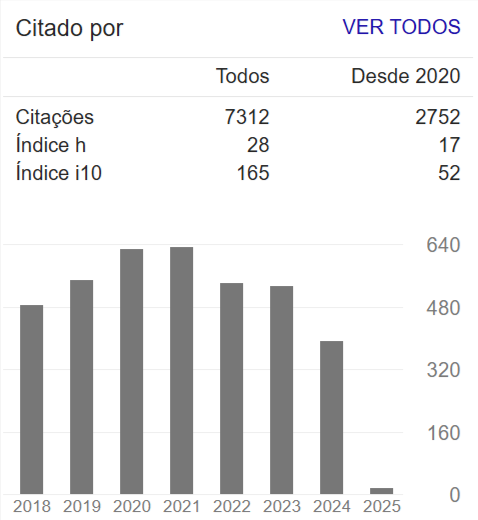Impactos sobre o solo e a água subterrânea e recomendações de boas práticas para estandes de tiro
Resumo
A contaminação do solo e da água subterrânea por atividades antrópicas é um problema complexo e custoso, especialmente em estandes de tiro, que liberam resíduos de munição que, ao se fragmentarem, podem contaminar o solo e aquíferos. A crescente conscientização sobre a responsabilidade ambiental dos centros de treinamento de tiro exige o desenvolvimento de estratégias para mitigar a poluição e garantir a segurança dos usuários e do meio ambiente. No entanto, as ações de prevenção e controle para esta atividade ainda são limitadas. Estabelecimentos que utilizam para-balas de madeira, pneus e barrancos não cumprem os requisitos de proteção ambiental, potencializando a dispersão de contaminantes, principalmente metais pesados. Os altos custos e o longo tempo para recuperação destas áreas, especialmente quando a água subterrânea foi contaminada, reforçam a importância da prevenção. O objetivo deste trabalho foi chamar a atenção sobre os impactos ambientais associados aos estandes de tiro, particularmente sobre o solo e a água subterrânea, e propor recomendações de boas práticas que visem minimizar esses impactos e melhorar a segurança e sustentabilidade destes empreendimentos.
Referências
ALEMANHA. Gesetz zur Förderung der Kreislaufwirtschaft und Sicherung der umweltverträglichen Bewirtschaftung von Abfällen. 2012. DOI: https://doi.org/10.5771/9783802956317-663 DOI: https://doi.org/10.5771/9783802956317-663
BRASIL. Aperfeiçoamento e padronização da instrução de tiro por forças policiais - estandes de tiro - regulamentação e aspectos construtivos. 2023. Disponível em: https://www.gov.br/mj/pt-br/assuntos/sua-seguranca/seguranca-publica/pro-seguranca/guias-e-estudos-tecnicos/guia-estandes-de-tiro.pdf. Acesso em: 17 dez. 2024.
CDC. Lead (Pb) Poisoning. [s. d.]. 2024. DOI: https://doi.org/10.1037/e411502005-001 DOI: https://doi.org/10.1037/e411502005-001
CHEMELLO, E. Ciência Forense: balística. Química Virtual. p. 1-9, 2007.
CHRISTOU, A.; DALIAS, P.; DEMETRIOU, E.; CHRISTOFIDOU, M.; KOZAKOU, S.; MICHAEL, N.; CHARALAMBOUS, C.; HATZIGEORGIOU, M.; CHRISTOU, E.; STEFANI, D.; CHRISTOFOROU, E.; NEOCLEOUS, D. Lead contamination of soils, sediments, and vegetation in a shooting range and adjacent terrestrial and aquatic ecosystems: A holistic approach for evaluating potential risks. Chemosphere, v. 292, 2022. DOI: https://doi.org/10.1016/j.chemosphere.2021.133424 DOI: https://doi.org/10.1016/j.chemosphere.2021.133424
SOUZA, V. Avaliação da contaminação do solo por metais tóxicos (cádmio, cromo, chumbo e alumínio) em estandes de tiro no estado do Paraná/Brasil. Tese (Doutorado em Ambiente e Desenvolvimento) - Centro Universitário UNIVATES. Rio Grande do Sul: Porto Alegre, 2016. DOI: https://doi.org/10.29381/0103-8559/2020300182-6 DOI: https://doi.org/10.29381/0103-8559/2020300182-6
SOUZA, V.; KONRAD, O.; GONÇALVES JUNIOR, A. C. Exposição por chumbo dos profissionais de segurança pública na região de Cascavel-PR. Revista Verde de Agroecologia e Desenvolvimento Sustentável, v. 10, n. 4, p. 47-53, 2015. DOI: http://dx.doi.org/10.18378/rvads.v10i4.3626 DOI: https://doi.org/10.18378/rvads.v10i4.3626
ESTADOS UNIDOS. National Institute for Occupational Safety and Health - NIOSH. About NIOSH. Disponível em: https://www.cdc.gov/niosh/index.html. Acesso em: 23 out. 2024.
ESTADOS UNIDOS. Occupational Safety and Health Standards - OSHA. About OSHA. Disponível em: https://www.osha.gov/. Acesso em: 23 out. 2024.
EUROPA. Directive 2000/60/EC of the European Parliament and of the Council of 23 October 2000 establishing a framework for Community action in the field of water policy. 2000. DOI: https://doi.org/10.1017/cbo9780511610851.056
EUROPA. Directive 2008/98/EC of the European Parliament and of the Council. 2008. DOI: https://doi.org/10.1017/cbo9780511610851.056 DOI: https://doi.org/10.1017/CBO9780511610851.056
FAHRENHORST, C.; RENGER, M. The effects of very large amounts of lead, antimony and arsenic in agricultural soils in the vicinity of shooting ranges. Journal article: Verband Deutscher Landwirtschaftlicher Untersuchungs- und Forschungsanstalten, n. 32, p. 827-830, 1990. Disponível em: https://www.vdlufa.de/. Acesso em: 17 dez. 2024
FLØTRE, C. H.; VARSI, K.; HELM, T.; BOLANN, B.; BJØRKE-MONSEN, A. Predictors of mercury, lead, cadmium and antimony status in Norwegian never-pregnant women of fertile age. PLoS ONE, v. 12, n. 12, p. e0189169, 2017. DOI: https://doi.org/10.1371/journal.pone.0189169 DOI: https://doi.org/10.1371/journal.pone.0189169
HARCLERODE. M. A.; LAL, P.; VEDWAN, N.; WOLDE, B.; MILLER, M. E. Evaluation of the role of risk perception in stakeholder engagement to prevent lead exposure in an urban setting. Journal of Environmental Management, v. 184, p.132-142, 2016. DOI: https://doi.org/10.1016/j.jenvman.2016.07.045 DOI: https://doi.org/10.1016/j.jenvman.2016.07.045
KAJANDER, S.; PARRI, A. Management of the environmental impact of shooting ranges. Best Available Techniques, The Finnish Enviroment, v. 4, 2014. Disponível em: https://ym.fi/julkaisut. Acesso em: 21 out. 2024.
INSTITUTO SOU DA PAZ. Dados de clubes de tiro no Brasil via Lei de Acesso à Informação – 2023. [S. l.]: Instituto Sou da Paz, 2023. DOI: https://doi.org/10.22478/ufpb.1981-0695.2017v12n1.33788 DOI: https://doi.org/10.22478/ufpb.1981-0695.2017v12n1.33788
ITRC. Characterization and Remediation of Soils at Closed Small Arms Firing Ranges. Washington, D.C.: Interstate Technology & Regulatory Council, 2003. Disponível em: https://itrcweb.org/wp-content/uploads/2024/09/SMART-1.pdf. Acesso em: 21 out. 2024.
KORTE, N. E. Zero-Valent Iron Permeable Reactive Barriers: A Review of Performance. United States, 2001. DOI: https://doi.org/10.2172/814389 DOI: https://doi.org/10.2172/814389
LI, P.; KARUNANIDHI, D.; SUBRAMANI, T.; SRINIVASAMOORTHY, K. Sources and Consequences of Groundwater Contamination. Archives of environmental contamination and toxicology, v. 80, n. 1, p. 1-10, 2021. DOI: https://doi.org/10.1007/s00244-020-00805-z DOI: https://doi.org/10.1007/s00244-020-00805-z
MARIUSSEN, E.; LJØNES, M.; STRØMSENG, A. Use of sorbents for purification of lead, copper and antimony in runoff water from small arms shooting ranges. Journal of Hazardous Materials, v. 243, p. 95-104, 2012. DOI: https://doi.org/10.1016/j.jhazmat.2012.10.005 DOI: https://doi.org/10.1016/j.jhazmat.2012.10.005
NI, S.; RAHMAN, S.; KASAI, S.; YOSHIOKA, S.; WONG, K. H.; MASHIO, A. S.; HASEGAWA, H. Remediation of lead-contaminated shooting range soil: Biodegradable chelator-assisted washing and subsequent post-treatment using FeCl and CaO. Environmental Technology & Innovation, v. 31, 2023. DOI: https://doi.org/10.1016/j.eti.2023.103172 DOI: https://doi.org/10.1016/j.eti.2023.103172
NSSF. Environmental Aspects of Construction and Management of Outdoor Shooting Ranges. 1997. 139 p. Disponível em: https://www.nssf.org/. Acesso em: 29 out. 2024.
NSSF. Why Your Range Should be Using HEPA Filter. 2017. Disponível em: https://www.nssf.org/articles/why-your-range-should-be-using-hepa-filters/. Acesso em: 29 out. 2024.
OKKENHAUG, G.; GEBHARDT, K. A. G.; AMSTAETTER, K.; BUE, H.L.; HERZEL, H.; MARIUSSEN, E.; ALMÅS, Å. R.; CORNELISSEN, G.; BREEDVELD, G.D.; RASMUSSEN, G.; MULDER, J. Antimony (Sb) and lead (Pb) in contaminated shooting range soils: Sb and Pb mobility and immobilization by iron based sorbents, a field study. J Hazard Mater, v. 307, p. 336-43, 2016. DOI: https://doi.org/10.1016/j.jhazmat.2016.01.005 DOI: https://doi.org/10.1016/j.jhazmat.2016.01.005
OLMEZ, I.; KOTRA, J. P.; LOWERY, S.; ZOLLER, W. H. Airborne lead and trace elements in an indoor shooting range: A study of the DC National Guard armory pistol range. Environmental Toxicology and Chemistry, v. 4, p. 447-452, 1985. DOI: https://doi.org/10.1002/etc.5620040404 DOI: https://doi.org/10.1002/etc.5620040404
OMS. Envenenamento por chumbo mata cerca de 1 milhão de pessoas todos os anos. Organização Mundial da Saúde. 2022. Disponível em: https://news.un.org/pt/story/2022/10/1804252#:~:text=A%20cada%20ano%2C%20cerca%20de,elemento%20qu%C3%ADmico%20podem%20ser%20irrevers%C3%ADveis. Acesso em: dia Out. 2024.
RAABE, S. Bullet recycler gets lead out. Denver Post. 2007.
RODRÍGUEZ-SEIJO, A.; LAGO-VILA, M.; ANDRADE, M. L.; VEGA, F. A. Pb pollution in soils from a trap shooting range and the phytoremediation ability of Agrostis capillaris. Enviromental Science and Pollution Research, v. 23, p. 1312–1323, 2016. DOI: https://doi.org/10.1007/s11356-015-5340-7 DOI: https://doi.org/10.1007/s11356-015-5340-7
SÁNCHEZ-CASTRO, I.; MOLINA, L.; PRIETO-FERNÁNDEZ, M.; SEGURA, A. Past, present and future trends in the remediation of heavy-metal contaminated soil - Remediation techniques applied in real soil-contamination events. Heliyon, v. 9, n. 6, 2023. DOI: https://doi.org/10.1016/j.heliyon.2023.e16692 DOI: https://doi.org/10.1016/j.heliyon.2023.e16692
SANDERSON, P.; QI, F.; SESHADRI, B.; WIJAYAWARDENA, A.; NAIDU, R. Contamination, Fate and Management of Metals in Shooting Range Soils—a Review. Current Pollution, v. 4, p. 175–187, 2018. DOI: https://doi.org/10.1007/s40726-018-0089-5 DOI: https://doi.org/10.1007/s40726-018-0089-5
SHARMA, A.; SACHDEVA, S. Cadmium toxicity and its phytoremediation: A review. International Journal of Scientific and Engineering Research, v. 9, 395–405, 2015. Disponível em: https://www.ijser.org/researchpaper/Cadmium-Toxicity-And-Its-Phytoremediation-A-Review.pdf. Acesso em: 29 out. 2024.
SHARMA, J. K.; KUMAR, N.; SINGH, N. P.; SANTAL, A. R. Phytoremediation technologies and their mechanism for removal of heavy metal from contaminated soil: An approach for a sustainable environment. Frontiers in Plant Science, v. 14, p. 1076876, 2023. DOI: https://doi.org/10.3389/fpls.2023.1076876 DOI: https://doi.org/10.3389/fpls.2023.1076876
SHIN, D. Y.; LEE, S. M.; JANG, Y.; LEE, J.; LEE, C. M.; CHO, E.; SEO, Y. R. Adverse Human Health Effects of Chromium by Exposure Route: A Comprehensive Review Based on Toxicogenomic Approach. International Journal of Molecular Sciences, v. 24, n. 4, p. 3410, 2023. DOI: https://doi.org/10.3390/ijms24043410 DOI: https://doi.org/10.3390/ijms24043410
SORVARI, J.; ANTIKAINEN, R.; KOSOLA, M.; HOKKANEN, P.; HAAVISTO, T. Eco-efficiency in contaminated land management in Finland – Barriers and development needs. Journal of Environmental Management, v. 90, n. 5, p. 1715-1727, 2009. DOI: https://doi.org/10.1016/j.jenvman.2008.11.002 DOI: https://doi.org/10.1016/j.jenvman.2008.11.002
TABELIN, C. B.; IGARASHI, T.; VILLACORTE-TABELIN, M.; PARK, I.; OPISO, E. M.; ITO, M.; HIROYOSHI, N. Arsenic, selenium, boron, lead, cadmium, copper, and zinc in naturally contaminated rocks: A review of their sources, modes of enrichment, mechanisms of release, and mitigation strategies. Science of The Total Environment, v. 645, p. 1522-1553, 2018. DOI: https://doi.org/10.1016/j.scitotenv.2018.07.103 DOI: https://doi.org/10.1016/j.scitotenv.2018.07.103
TAN, H. W.; PANG, Y. L.; LIM. S.; CHONG, W. C. A state-of-the-art of phytoremediation approach for sustainable management of heavy metals recovery. Environmental Technology & Innovation, v. 30, 2023. DOI: https://doi.org/10.1016/j.eti.2023.103043 DOI: https://doi.org/10.1016/j.eti.2023.103043
U.S. EPA. Best management practices for lead at outdoor shooting ranges. New York, 2005. 86 p. Disponível em: https://www.epa.gov/lead/best-management-practices-lead-outdoor-shooting-ranges. Acesso em: 02 out. 2024.
U.S. EPA.. Phytoremediation of Contaminated Soil and Ground Water at Hazardous Waste Sites. EPA/ 540/S-01/500. Office of Research and Development, Washington, 2001. Disponível em: https://www.epa.gov/sites/default/files/2015-06/documents/epa_540_s01_500.pdf. Acesso em: 02 out. 2024.
ZHU, Y.; CHE, R.; TU, B.; MIAO, J.; LU, X.; LI, J.; ZHU, Y.; WANG, F. Contamination and remediation of contaminated firing ranges—an overview. Frontiers in Environmental Science, v. 12, p. 1352603, 2024. DOI: https://doi.org/10.3389/fenvs.2024.1352603 DOI: https://doi.org/10.3389/fenvs.2024.1352603

















